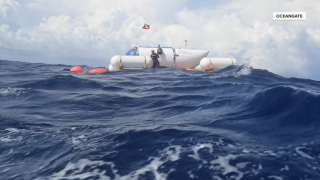
Crews are in the fourth day of searching an area twice the size of Connecticut and nearly 2.5 miles deep, looking for five people on board a missing submersible near the wreck of the Titanic.
Efforts are now narrowing in on an area where Canadian aircraft detected banging underwater.
“It may just be people banging on the side, taking a piece of metal and banging on the side of the submersible,” Captain Robert Sanders, retired Navy JAG and distinguished lecturer in the National Security Department at the University of New Haven.
Sonar buoys are now being used to try to distinguish manmade sounds in the Atlantic.
Get Connecticut local news, weather forecasts and entertainment stories to your inbox. Sign up for NBC Connecticut newsletters.
“Banging in a certain rhythm that doesn't meet the natural rhythms of the ocean will be evident that it's not coming from the natural environment, it's coming from men,” Sanders said.
Sanders is a retired Navy JAG captain who has not only worked with military submarines, but also with commercial subs as an engineer and a lawyer. He says the missing submersible is extremely different from those other vessels, which may not dive as deep and would be equipped with much more electronic gear to sense their surrounds.
“I don't think this vessel has that level of sophistication. As matter of fact, I was shown at one point in someone's film that one of the controllers they use was one from a game in system controller,” Sanders said. “It seems like the vessel itself, the exterior, was able to do what it has been doing: go to deep, deep, deep depths. But the equipment inside, just based on a game controller, makes it no way near the commercial ones that I've been on or the military ones that I've been on.”
Local
If the sub is at the depths of the ocean, Sanders says conditions would be close to intolerable.
“The water outside that submersible, which is probably not heated very well, is about 29 degrees below zero, and you’re sitting in a big metal tube,” he said. “Think about being trapped in a can, half dozen people for a period of days. Bathrooms, normal bodily functions, eating, sleeping, everything you have to do happens in that can. And it's cold.”
“It's total blackness. So without manmade illumination, you can't see anything, and under pressure, you're talking over 5,000 pounds per square inch where the Titanic is. The pressure is enormous,” said Philip Vitiello, a Titanic historian based in New Haven.
There have been many missions to the Titanic since the wreck was discovered, according to Vitiello, a member of the Titanic Historical Society.
“Bob Ballard discovered the Titanic on September 5, 1985, and then went back,” he said. “The French has been have been down there over the years. When James Cameron was filmed making the movie ‘Titanic’ he took many trips down there.”
Yet Vitiello says each expedition comes with great risk in the unforgiving Atlantic.
“This isn't a joy ride,” Vitiello said. “This is very serious business to take a trip like that. There are more people that have flown in space than have visited the Titanic. I know they knew the risks, and there was always that chance something tragic can happen. I just hope there's going to be a positive ending to this.”



